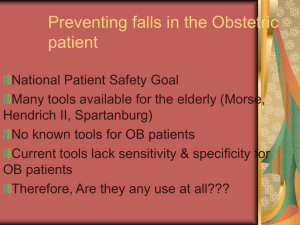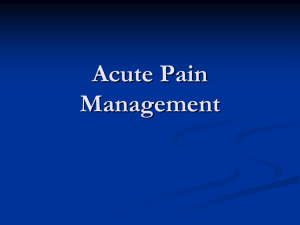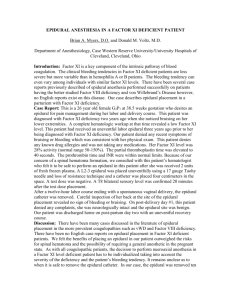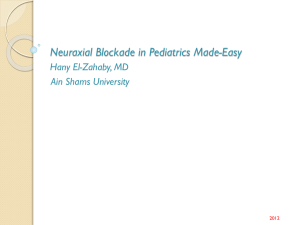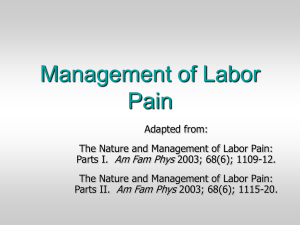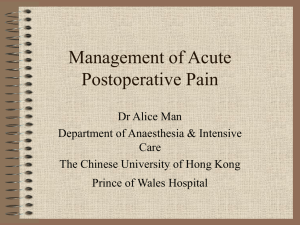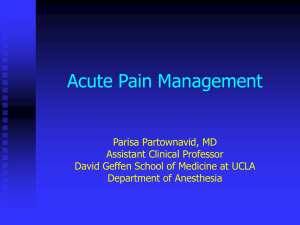Cancer pain management - Yorkshire and the Humber Deanery
advertisement
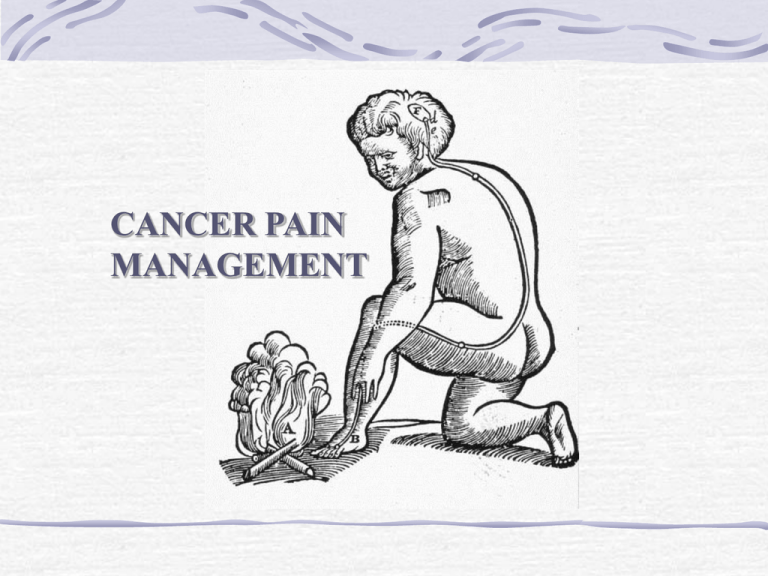
CANCER PAIN MANAGEMENT Cancer pain management Pain control should encompass “total pain” Pain management specialists should not work in isolation Education is fundamental to good pain management Education in cancer pain management A survey of physicians actively involved in cancer care 1/3 wait until prognosis <6 months before giving maximal analgesia (Von Roenn et al. 1993) A study of 81 doctors only 5% could convert a parenteral dose of morphine to an equivalent of MST they were unfamiliar with palliative use of radiation (Mortimer and Bartlett 1997). Cancer pain has increased worldwide an ageing population WHO - 4 million people in the world have cancer pain Site of primary tumour important Pain not usually significant in early disease 1/3 with metastatic disease have significant pain Most patients with end stage disease have pain >50% patients report <70% pain relief with analgesics Breakthrough pain Transitory exacerbation of severe pain on a background of otherwise stable chronic pain in a patient on regular opioids Incidence about 63% Median number 4 severe breakthroughs per day Median duration 30 minutes Incident pain is breakthrough pain related to movement (Portenoy & Hagen, 1990) Basic pain management principles Decrease pain and improve quality of life Do no further harm Allow patient and carers choices Use resources as effectively as possible Disease modification Surgery Radiation Chemotherapy Biological therapy Basic pain management Oral opioid analgesics Adjuvant analgesics WHO principles Neuropathic pain Individual variation Opioid switching Clinical bottom line Paracetamol remains 1st line Topical NSAIDs do work (NNT = 3) - no GI NSAID COXIBs Ibuprofen (<2400 mg/day) probably GI protection for those at risk offer advantages in terms of GI s short prognosis Adjuvant analgesics Tricyclic antidepressants NNT = 3.0 30% patients >50% pain relief 30% minor adverse reactions 4% have to stop treatment SSRIs less effective (50% reduction side No difference in efficacy across differen Adjuvant analgesics – anticonvulsants NNT = 2.6 in trigeminal neuralgia Evidence of efficacy in diabetic neur Evidence of efficacy in migraine prop Relatively high risk for minor advers Difficult cancer pain may need specialist pain management The WHO guidelines fail in 10-15% patients This may be due to: opioid resistance intolerable drug side effects inability to deliver drugs effectively e.g. GI problems Alternatives local anaesthetic/steroid somatic/sympathetic nerve blocks neurolytic blocks spinal ITDD neuro-destructive surgical procedures Combined approach aimed at several different levels within the nervous system provides optimum relief with least adverse effects Simple nerve blocks Complex Nerve Blocks Autonomic Nerve Blocks Spinal drug delivery Much smaller drug doses are needed 2% patients with cancer pain When simpler and more economic methods have failed Indications failure of systemic treatment intolerable drug side effects Epidural or intrathecal drug delivery External & internal systems Choice of patient for spinal drugs Contraindications Local or systemic infection Non-correctable co-aggulopathy Patient refusal Indications Segmental pain or spasticity Not head pain ? Neuropathic pain, ? Visceral pain, incident and cutaneous pain Investigations Cord compression ? Good CSF flow Life expectancy External or internal systems Life expectancy > 3 months ? Intrathecal or epidural drug delivery? Intrathecal drugs need not pass dura Used in lower doses (10-20% epidural dose). Large volume epidurally - spinal cord compression Change in epidural fat influences drug delivery. Epidural catheters blocked by fibrosis Intrathecal or epidural drug delivery? Complications within 20 days after implant Intrathecal 25% Epidural 8% CSF leak was the main intrathecal complication Complications after 20 days after implant Intrathecal 5% Epidural 55% Epidurals frequently obstruct or dislodge Implantable or external system? •Pain problem •Patient’s condition •Experience of the team Spinal drugs – infection Infection rates vary 1 per 168 - 1 per 2446 catheter days 20% cultures from cassettes, syringes and filters colonised without clinical Infection associated with prolonged catheter placement time > 100 min Medtronic system Spinal drug delivery Pain may change as patient approaches the end of life Small pump reservoir may mean alternative method of analgesia needed Clinical bottom line Pain relief better with intrathecal than epidural systems Treatment failures more common with external epidural cathet compared with internal IT catheters Treatment failures less common with internalised IT catheters than with internalised epidural catheters Higher rates of system removal with internalised epidural catheters than with internalised IT catheters Higher rates of catheter complications with epidural than with IT catheters Spinal drugs Opioids Clonidine Ketamine Octreotide Midazolam Neostigmine Baclofen Local anaesthetics Ziconatide Spinal drugs – adverse effects Dose escalation - Spinal opioid rotation Sedation or itching with opioids Hypotension with clonidine Motor block with local anaesthetics Subtle personality change with ketamine Hormonal and immune suppression with opioids Conclusions A multi-disciplinary approach Lessons now being applied to Non-cancer pain >25,000 patients have been treated world-wide

